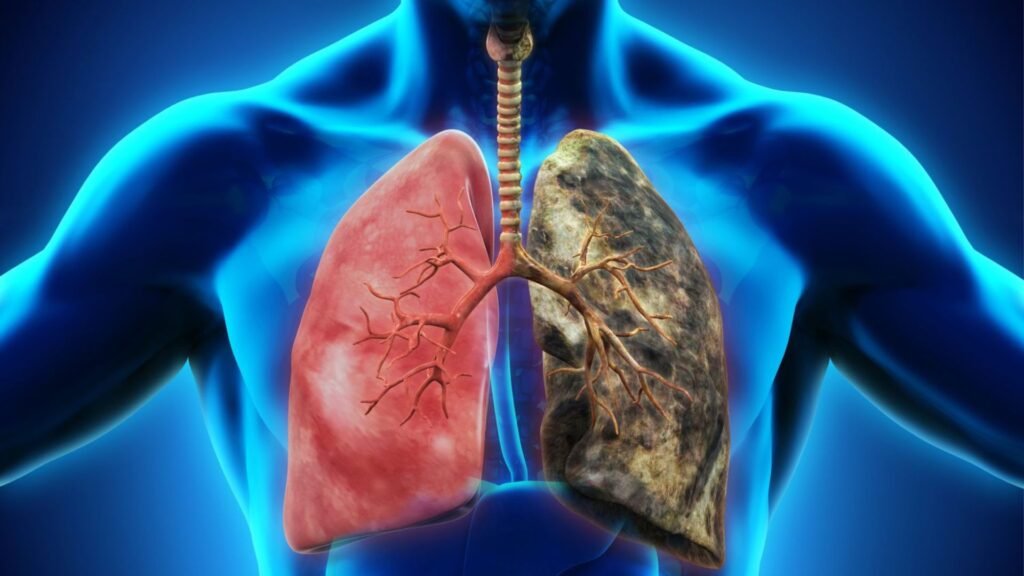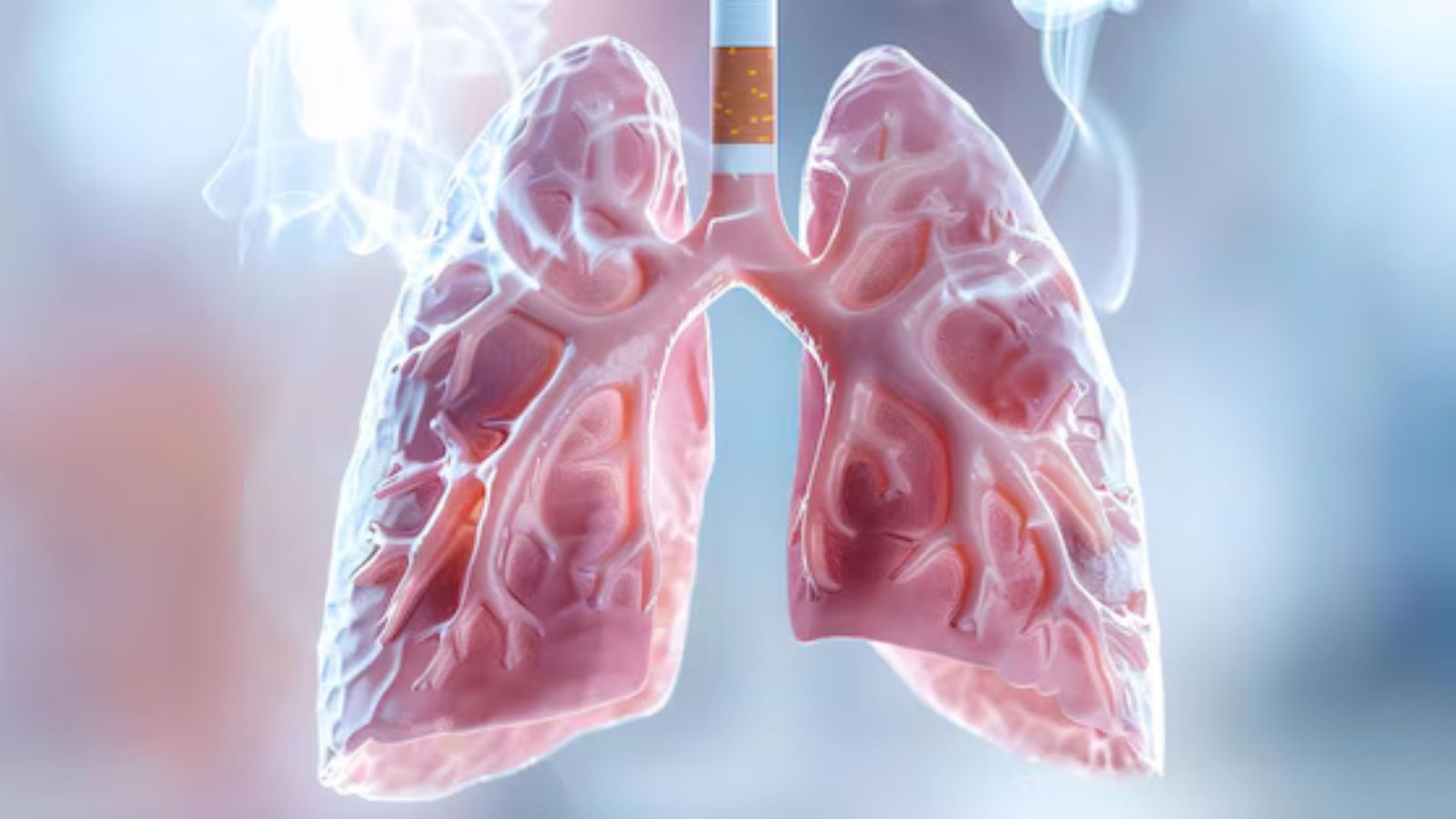Health Impacts Of Smoking On Lung Function
Smoking is one of the most harmful habits for overall health, particularly when it comes to lung function. The effects of smoking on the lungs are severe, and the damage often leads to chronic diseases like COPD (Chronic Obstructive Pulmonary Disease), emphysema, and even lung cancer. In this article, we will explore how smoking harms the lungs and the long-term consequences it can have on respiratory health.

1. Damages Airway and Lung Tissue
When you smoke, harmful chemicals in tobacco smoke enter the lungs and cause damage to the airways and lung tissue. These toxins are absorbed directly into the bloodstream, and over time, they weaken the lungs’ ability to function properly.
- How It Happens: The chemicals in cigarette smoke irritate the lining of the lungs, leading to inflammation. This inflammation damages the alveoli (tiny air sacs in the lungs), making it harder to breathe.
- What You Can Do: Quitting smoking is the most effective way to prevent further damage. The body begins to repair itself once you stop, though the process may take years.
2. Increased Risk of Chronic Obstructive Pulmonary Disease (COPD)
COPD is a group of lung diseases, including chronic bronchitis and emphysema, that makes it difficult to breathe. Smoking is the leading cause of COPD and accelerates its progression.
- How It Happens: The smoke damages the airways and alveoli, causing them to become inflamed and narrow. This reduces airflow to and from the lungs, leading to symptoms like shortness of breath, wheezing, and chronic cough.
- What You Can Do: Stopping smoking is the most important step in managing COPD. Early detection and treatment can help slow down the disease’s progression and improve quality of life.
3. Reduces Oxygen Flow to the Lungs
Smoking directly affects the ability of your lungs to absorb oxygen. The toxic chemicals in cigarettes reduce the effectiveness of the lungs in transferring oxygen to the blood.
- How It Happens: Smoking reduces the amount of oxygen available for your body by damaging the lungs’ ability to exchange gases efficiently. This leads to lower oxygen levels in the blood and a feeling of breathlessness.
- What You Can Do: Quitting smoking improves lung function and helps restore oxygen levels in the blood. In some cases, the lungs may even regain partial capacity to absorb oxygen after quitting.
4. Increased Mucus Production
Smoking irritates the airways and causes the lungs to produce excess mucus. This can lead to chronic coughing, wheezing, and an increased risk of infections.
- How It Happens: The toxins in cigarette smoke stimulate the production of mucus as a defense mechanism. However, this excess mucus can obstruct airways, making it harder to breathe.
- What You Can Do: Quitting smoking will reduce mucus production, helping to clear the airways and improve overall lung function.
5. Higher Risk of Lung Cancer
Lung cancer is one of the leading causes of death among smokers. Smoking is responsible for approximately 85% of lung cancer cases, and it greatly increases the risk of developing the disease.
- How It Happens: The carcinogens in cigarette smoke damage the DNA in lung cells. Over time, these genetic mutations can cause abnormal cell growth, leading to the development of cancer.
- What You Can Do: The risk of lung cancer decreases after quitting smoking, though it never completely returns to that of a non-smoker. Early detection and screening are essential for those who have smoked.
6. Decreased Lung Growth in Young Adults
Young people who smoke face unique risks when it comes to lung development. Smoking during adolescence or young adulthood can stunt the growth of the lungs, leading to long-term consequences.
- How It Happens: Smoking during lung development in youth can cause irreversible damage to lung tissue. It affects the growth and elasticity of the lungs, leaving them less able to function fully in adulthood.
- What You Can Do: Preventing smoking from an early age is key to ensuring healthy lung development. Quitting smoking at any age can still improve lung health, but starting early provides the best protection.
7. Weakened Immune System in the Lungs
Smoking weakens the immune system in the lungs, making smokers more susceptible to respiratory infections and diseases, including pneumonia, bronchitis, and the flu.
- How It Happens: The chemicals in cigarette smoke impair the function of the lungs’ natural defense mechanisms, such as cilia (tiny hair-like structures that help clear debris). This makes it harder for the lungs to fight off harmful bacteria and viruses.
- What You Can Do: Quitting smoking improves the immune function of the lungs and reduces the risk of infections. Regular exercise and a healthy diet also support lung health.
8. Increased Inflammation in the Lungs
Smoking increases inflammation in the lungs, which can lead to various respiratory issues. Chronic inflammation damages lung tissue over time and contributes to diseases like asthma, bronchitis, and emphysema.
- How It Happens: The chemicals in cigarette smoke cause the immune system to react, leading to chronic inflammation in the airways. This inflammation can result in thickening of the airway walls and narrowing of the bronchi, which makes breathing difficult.
- What You Can Do: Quitting smoking reduces inflammation in the lungs, and symptoms like wheezing, coughing, and shortness of breath may improve over time.
9. Reduced Lung Function Over Time
Lung function naturally declines with age, but smoking accelerates this process. Chronic smokers often experience a significant loss of lung capacity, which impacts their ability to perform everyday activities.
- How It Happens: Smoking damages the alveoli, reducing the surface area available for oxygen exchange. This causes a decline in lung function, making it harder to breathe even during simple activities like walking or climbing stairs.
- What You Can Do: Quitting smoking slows down the rate of lung function decline. In some cases, stopping smoking can help preserve lung capacity for years.
10. Chronic Cough and Shortness of Breath
One of the most common signs of smoking-related lung damage is a persistent cough, often referred to as “smoker’s cough.” This chronic cough can be accompanied by shortness of breath, even during light physical activity.
- How It Happens: Smoking irritates the airways, leading to increased mucus production and coughing. Over time, this chronic irritation can lead to long-term lung damage and difficulty breathing.
- What You Can Do: Quitting smoking can significantly reduce coughing and shortness of breath. Additionally, lung function may improve after a period of not smoking.
Conclusion
Smoking has a wide range of harmful effects on lung function. From reducing oxygen levels to increasing the risk of chronic diseases like COPD and lung cancer, the damage caused by smoking is extensive. However, the good news is that quitting smoking can have immediate and long-term benefits. The lungs begin to repair themselves shortly after quitting, and the risk of developing severe respiratory diseases gradually decreases. The sooner you quit, the greater the chances of preserving your lung function and overall health. If you’re struggling to quit, seeking support from healthcare professionals can significantly improve your chances of success.



